Landscape of the Moon's Last Phase (1944)
Paul Nash review – between dream and nightmare
Tate Britain, London
Strangeness on the Downs meets the horrors of two world wars in the biggest show of Nash’s work in a generation
Laura Cumming
The Obserber
Sunday 6 November 2016
Out walking, you are confronted by a long column of trees approaching across a bare winter landscape. You stop, and it seems as if they stop too. Stationed before them – the field marshal commanding his troops – stands a stone pillar topped with a pale sphere. And this sphere has a peculiarly exact echo in the white moon hanging beside it in the sky: English pastoral geometry.
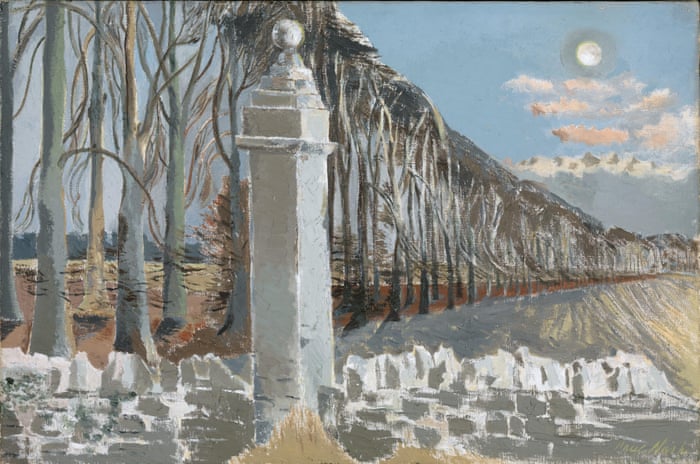
Pillar and Moon (1932 - 42)
Pillar and Moon is not just one of Paul Nash’s greatest works, it encapsulates the painter’s gift for mood, mystery and strange alignment. Every element of the scene is independently familiar – the parade of vertical trunks, the low-hanging moon, the architectural remnant of some aristocratic parkland – but all are made extraordinary and oneiric. The positioning of the two discs may be significant, or meaningless, but it holds the mind in wonder. The atmosphere feels dazed and convalescent.

Equivalents for the Megaliths (1935)
Nash died of heart failure, brought on by chronic asthma, in a Bournemouth suburb in 1946. He was 57, and had narrowly escaped gassing and death more than once in the first world war. He lost consciousness several times during his curtailed life, and his bleached and dreamy landscapes seem to hold on to the light as if it might fade. And landscape is where everything happens in Nash’s art: outdoors is his internal stage.
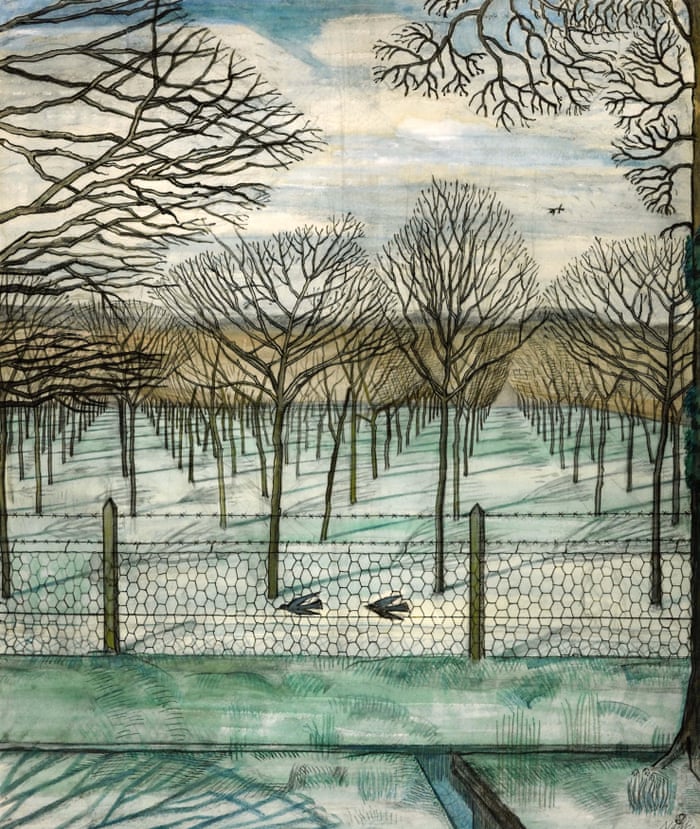
The Cherry Orchard (1917)
Sunday 6 November 2016
Out walking, you are confronted by a long column of trees approaching across a bare winter landscape. You stop, and it seems as if they stop too. Stationed before them – the field marshal commanding his troops – stands a stone pillar topped with a pale sphere. And this sphere has a peculiarly exact echo in the white moon hanging beside it in the sky: English pastoral geometry.

Pillar and Moon (1932 - 42)
Pillar and Moon is not just one of Paul Nash’s greatest works, it encapsulates the painter’s gift for mood, mystery and strange alignment. Every element of the scene is independently familiar – the parade of vertical trunks, the low-hanging moon, the architectural remnant of some aristocratic parkland – but all are made extraordinary and oneiric. The positioning of the two discs may be significant, or meaningless, but it holds the mind in wonder. The atmosphere feels dazed and convalescent.
Equivalents for the Megaliths (1935)
Nash died of heart failure, brought on by chronic asthma, in a Bournemouth suburb in 1946. He was 57, and had narrowly escaped gassing and death more than once in the first world war. He lost consciousness several times during his curtailed life, and his bleached and dreamy landscapes seem to hold on to the light as if it might fade. And landscape is where everything happens in Nash’s art: outdoors is his internal stage.

The Cherry Orchard (1917)
The Cherry Orchard, beautifully positioned at the entrance to this enormous show– the first full-stretch survey in a generation – sets the tone from the start. An array of trunks casts diagonal shadows on the landscape, which is divided again by wire fencing as the sky is crisscrossed by stark branches. These are the bare ruin’d choirs of Shakespeare, and yet the watercolour was made in leafy July. Nash was temporarily home from the trenches in 1917. His image is distanced from life, while partaking of it: he sees the ribs, bones and ghosts in the landscape.
Trees march by night, hugger-mugger in the darkness. Huddled together, they watch dawn break over the horizon. Their trunks lie felled, vast as the ancient stones of Wiltshire, or protrude upright, shattered and amputated, from the black mud of Ypres. They are bodies, and sometimes corpses, yet never people.
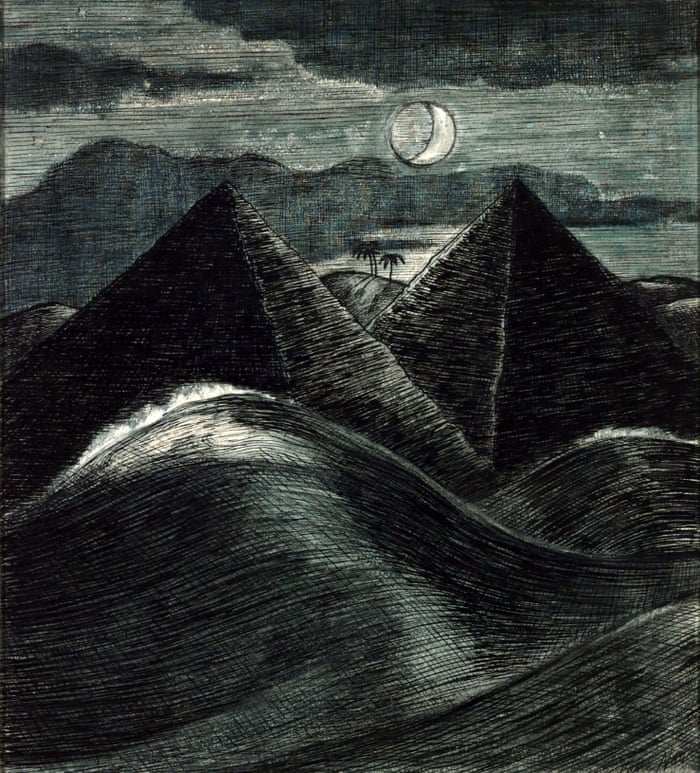
The Pyramids in the Sea (1912)
It was noted at the Slade – where Nash studied in the diverse generation that included Ben Nicholson, Wyndham Lewis and Stanley Spencer – that the human figure would never be his forte. People do appear in his art, surprisingly often, but always as wraiths or surrogates. Far more haunting are nature’s figures, such as the two tiny trees holding still at the centre of The Pyramids in the Sea.
This irreducibly strange vision shows roiling seas by night, two pyramids dropped among them, and sand dunes metamorphosing into waves. It is a vision from the land of counterpane, made when Nash was scarcely 23. Yet it contains the future like a kernel – the intermingling of land and sea, the premonition of surrealism,the Samuel Palmer moon (long before Palmer was discovered in the 1920s) of Nash’s English nocturnes. Above all the bell-shaped waves that rise and fall across the picture, and all through the rest of his work.
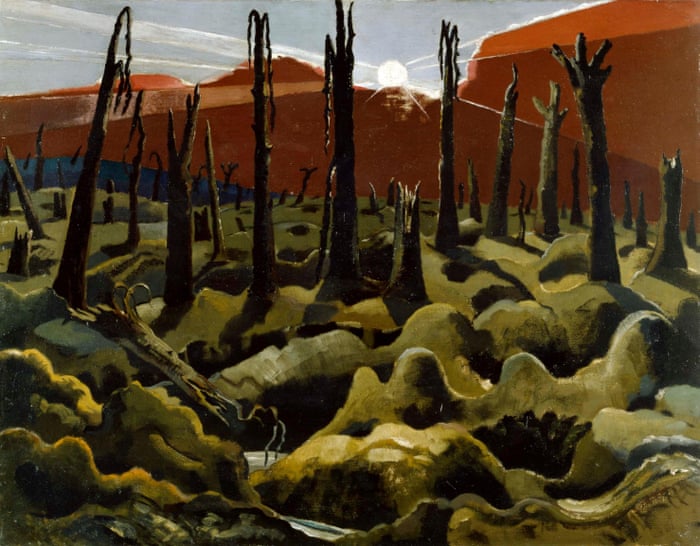
We Are Making a New World (1918)
You see these in his devastating masterpiece We Are Making a New World (1918), where the spiked rays of the sun radiate like searchlights above a sea of tragic humps – the churned and deadly trenches. And it is there in weird vernal hillscapes painted during the second world war. Cumulus mounts over the Channel in swelling curves and descends in matching formations with the dark plumes of crashing aeroplanes.
Landscape for a Dream (1936-8)
Nash is routinely described as Britain’s foremost surrealist. But his consciously surreal paintings are as mediocre as his effortful still lifes. It is a pity Tate Britain has given quite so much space to both, but the curators are intent on dutiful chronology and dust-dry modernist history. Nash’s life is hardly mentioned in the captions, as if he didn’t have one, and a whole room is devoted to his fellow artists in the Unit One group – Hepworth, Moore, the Edwards Burra and Wadsworth – when their work is available in galleries upstairs.
Events on the Downs (1934)
It is true that Nash’s paintings sometimes have the period look – the chalky surface, the mildly sardonic, gas-fire plangency – of London painting in the 1920s. It is also true that for a brief period he painted receding tunnels and metaphysical objects in the obvious shadow of De Chirico. But soon Nash is off on his own again with strange incidents on the Downs and startling shorelines at Dymchurch in Kent, where he rented a cottage after a nervous breakdown.

The Shore (1923)
Here the cold waves clatter like wrecked fuselage or turn into solid planes of ice, stretching into the darkness beneath a grey moon. In that marvellous painting The Shore, made in 1923, the postwar defences lie face-down, as it seems, like a vast plane crashed upon the beach. Later, in the second world war, Nash draws the bones of aircraft lying exposed in the earth, or dangling from wires, or surfacing out of seas of corn. To come upon them in the landscape must have been as surprising as this – like chancing on the skeleton of a dinosaur.
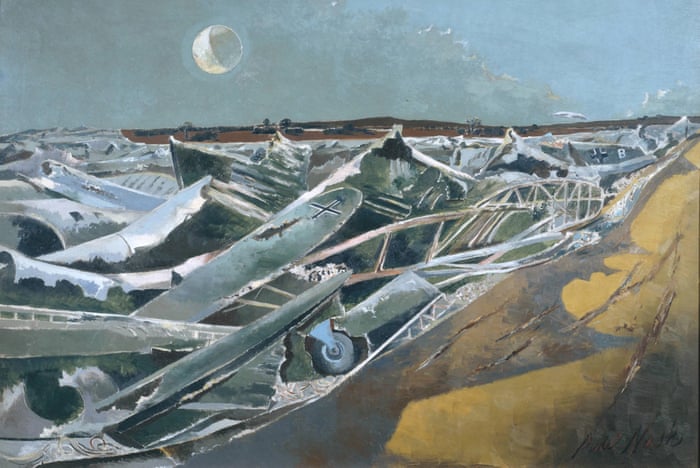
Totes Meer (Dead Sea) (1940-41)
And everything Nash paints has that curious timelessness. The aeroplanes in his most famous masterpiece, Totes Meer (Dead Sea), could almost be old ships, but for the markings, or frozen waves, but for a solitary wheel. They pack the painting like the icebergs of Scott’s doomed expedition to Antarctica, and yet they seem even older, appearing beneath the flight of an owl and a crescent moon. The picture was painted in 1940-1, but it could be set in a nuclear winter.
Nash was a writer as well as a painter, and he left many piercing statements about his work. “There are places,” he wrote, “whose relationship of parts creates a mystery, an enchantment, which cannot be analysed.” This is what his own paintings imagine. In the quiet of the studio, he turned his journey through the English landscape into new and mysterious visions that are so close to reality – the sun appearing at the same time as the moon, a crown of trees suddenly rising out of winter’s tilled earth – as to carry the enchantment of which he writes. And then, with some inexplicable switch of atmosphere, alignment and elements, he makes this world even stranger.









No comments:
Post a Comment